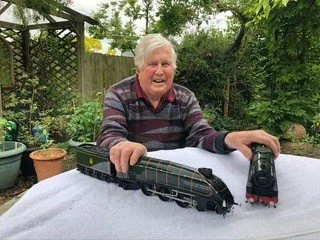Steam engines have always fascinated me. When my father returned from WW2 he showed me the lathe and work-bench in the basement of the family house in London where he had planned before the war to build his own model railway.
He had also amassed volumes of the Railway magazine – which I still have – containing fine colour prints of notable locos.
He did not stay longer with us to do this but in the loft of our new home I found remnants of this resolve lodged between dusty rafters: parts of a clockwork O-gauge LMS shunting loco, in mulberry livery, a mass of points and rails… but that was all.
But my interest was already aroused and when we passed through Kings Cross station on our way home we looked enviously at the passengers sitting cosily in their Tees-Tyne Pullman compartments taking their first evening drink; and then further on to the locomotive, usually a stream-lined A4 Pacific, waiting, like a barely constrained race-horse, for the signals to change and the guard’s whistle to blow. Wisps of steam escaped from its great gleaming body, there was a wonderful smell of hot oil and we could hear the clank of the fireman’s shovel as he stoked up the boiler.
The Udaipur Express
With my two model locos, Empire of India (left) and the
Black Watch (right)
Many years later while working in India we travelled down from Delhi to Udaipur on the Udaipur Express, an 18-hour journey. Cinders from the engine blew into our compartment and a sweeper would come in and clean up. This was epic travel when food and bedding were delivered at the next station down the line. Sadly, I never managed to take the mountain train up from Jalgaiguri to Darjeeling.
Back in the UK my father, now retired, ran his own diesel engine on the Ffestiniog Railway. It had to be started by hand turning a large flywheel. We feared he would suffer a heart-attack but he was well up to the task. The railway management sent him on a driver’s course after he derailed his loco.
My interest in railways lapsed after this until recently in an idle moment I started to surf the internet and came across second-hand Bassett-Lowke locos for sale (BL had been sold to Hornby Trains!).
What I was looking for was an A4 Pacific – the record-breaking Mallard designed by Sir Nigel Gresley – the streamlined loco prow inspired apparently by Bugatti cars seen by Gresley on holiday in Italy.
The call of wild geese
These were magnificent machines of classic graceful design with their six-foot diameter driving wheels. Even their two-toned claxons were romantic, sounding like wild geese in flight. We watched them thundering up the Great North line on the way to Newcastle and Edinburgh. But now Mallard has retired to the Railway Museum in York with other wonders of steam.
No models of the Mallard were on sale and so I purchased a second-hand Bassett-Lowke Empire of Britain loco bearing the name of my old regiment, Black Watch, and it now stands proudly on a shelf by my desk.
But recently I have now been able to buy a 0gauge A4 Pacific loco from AceTrains, not Mallard but the Empire of India, which used to run from Euston and up the west coast. It now stands alongside my other loco.
Out of this window I can see the diggers and cranes gouging out the fine green Buckinghamshire turf to make way for the HS2 track to Birmingham. In a few years, electric trains will shoot along it at over 150mph, scooping up vast amounts of electricity from the grid.
They will be well beyond the capacity of a restored A4 Pacific. But I will look wistfully at my locos and recall the great age of steam they represented.
